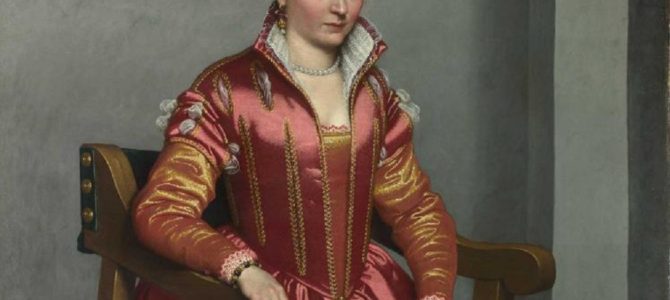
When considering Italian Renaissance artists, the name Giovanni Battista Moroni (circa 1520/24–1579/80) doesn’t exactly spring to mind. In his own day he was so unknown that his contemporary Giorgio Vasari, when writing his famous “Lives of the Artists,” didn’t even mention Moroni in passing. The first major exhibition dedicated to Moroni’s work ever mounted in the United States, which opened recently at the Frick Collection in New York, should go some way toward correcting that oversight.
Moroni was born in the town of Albino, near the city of Bergamo in Lombardy, northern Italy. Most of his extant work was created for individuals or institutions in that part of the world. There is little documentation about his life, and he doesn’t seem to have ventured very far from home for most of his career. We don’t even know for certain what he looked like.
With so little background information to go on, collectors of and commentators on Moroni’s work have had to rely on their own judgment, and less on the kind of hagiography that often accompanies the analysis and appreciation of the Old Masters.
Of the roughly 200 works known or believed to be by Moroni that survive, the overwhelming majority are portraits, and most depict middle-aged and old men, dressed entirely in black. While many of these images are formulaic and somewhat dull, the kind of thing an artist paints to pay the bills, there are some remarkable exceptions. Fortunately for the visitor, several of these more exceptional works are in the Frick’s exhibition, and they allow us to see the naturalism that makes Moroni such an interesting painter.
For example, the portrait believed to be of Gabriele Albani, on loan from a private collection, was painted late in Moroni’s career around 1572-1573. It shows an elderly man with a long beard, dressed in a black silk gown lined in luxurious ermine fur, who stares straight out at the viewer.

Not only is the gaze and the composition arresting, but as the big welt on the man’s forehead shows, it’s a great example of how Moroni was a “warts and all” painter at a time when artists were often called upon to flatter their sitters, rather than paint them as they really were. As the exhibition’s accompanying text points out, Moroni was criticized for this by some art historians, such as Bernard Berenson, while others came to see his work as a kind of precursor to the often unattractively realistic style portrayed a generation later by Caravaggio.
Despite it being his bread-and-butter, Moroni did not limit his subject matter to old men, or his palette to somber colors. In fact, as one enters the first of the two galleries at the Frick displaying the exhibition, the eye is inevitably drawn to the artist’s love of the color pink. This exploration of every shade of pink, particularly on comparatively younger patrons, allowed Moroni to show how observant he could be when representing the effects of light on rose-colored fabrics.
Take a look, for example, at the portrait of an unknown woman known as “La Dama in Rosso” (“The Lady in Red”), which may depict the Countess Lucia Albani Avogadro. Painted sometime between 1554-1557, it shows an elegantly dressed young woman seated bolt upright in a chair, the scale of which indicates to us that the subject of the picture is somewhat petite.

She looks out at us calmly, perhaps with a hint of suspicion, shown by her slightly raised eyebrows. Standing in front of this painting, one is overwhelmed by her luxurious, pink satin gown edged with gold embroidery, which covers a dress made of iridescent, saffron-colored velvet. The effect is enhanced when one realizes that even the marble floor pattern is dominated by a shade of salmon pink.
The color pink also dominates the nearby portrait of Giovanni Gerolamo Grumelli, not surprisingly known as “Il Cavaliere in Rosa” (“The Gentleman in Pink”), on loan from the Moroni Foundation in Bergamo. Painted in 1560, it shows a standing young nobleman dressed entirely in pink, with a sword at his side.

Young but self-confident, and on his way up the social ladder, Grumelli prides himself not only on his appearance, but also on his education and intelligence, as alluded to by the fragments of Classical sculpture shown in the picture. He looks over his left shoulder, rather than out at the viewer, but like “The Lady in Pink,” he’s unquestionably a self-assured individual.
One of the best overall examples in the exhibition of what Moroni was able to achieve as an artist, combining both intensity of expression and brightness of color, can be seen in his exceptional portrait of Don Gabriel de la Cueva, the fifth duke of Albuquerque, a picture now owned by the Gemäldegalerie in Berlin. At the time Moroni painted this portrait, Philip II of Spain had just named de la Cueva the new viceroy of Navarra. In 1564 he was made governor of the Duchy of Milan, during a period when much of northern Italy was under Spanish rule.

Notice how Moroni not only gives us flashes of cranberry highlighted with coral beneath the inky velvet jerkin, but also brings out the pinkish, sunburned features of the weather-beaten soldier peering at us. The unflinching blue eyes are those of a veteran who has seen a lot of fighting in his day. Bradley Cooper could play him in a period war film in another few years.
If you came across the duke on the battlefield, you could be certain you were in for the fight of your life: the inscription on his right reads, in Spanish, “Aquí estoy sin temor y de la muerte no he pavor” (“Here I am without fear, and of death I have no dread”).
Arguably Moroni’s most famous painting, or at least his most popular, is his circa 1570 portrait known as “The Tailor,” lent for the exhibition by the National Gallery in London. In it, we see a bearded young man who appears to be in the middle of cutting cloth for a suit of clothes. Examining the painting up close, one can see the chalk lines on the fabric, just as one would today when having a custom suit made or alterations ordered.

The composition is highly unusual for its time, because it features a middle-class tradesman at work, and one who, as the accompanying placard points out, is not dressed in luxurious silks, but in more practical, albeit beautifully cut, wool garments. This is not a depiction of an aloof aristocrat dressed to the nines for court, but a contemporary of the artist who, for whatever reason, chose to be depicted for posterity in the act of doing his job.
In a related manner, the pair of portraits of Bernardio Spini and his wife Pace Rivola Spini are perhaps the most remarkable works in the show, even if they are neither the most colorful nor psychologically penetrating. Painted sometime between 1573-1575, and on loan from a museum in Moroni’s native Bergamo, these are life-sized canvases depicting a man in the fur trade, and his heavily pregnant wife.
As the accompanying exhibition placard on the image of the latter points out, this is the first known full-sized portrait painting of a woman executed at full length in Renaissance art. What is particularly surprising of both paintings, however, is that they are painted on a monumental scale that has nothing to do with the couple’s status.
Today, when most social conventions have gone out the window, it may be difficult for contemporary eyes to perceive what a bold and revolutionary pair of paintings these would have been considered at the time of their execution, particularly that of the Signora Spini. While she came from a locally important family, and her husband was a successful merchant, she was certainly not someone who, under normal circumstances, would have dreamed of having herself portrayed in such a regal fashion.

This painting would likely have been considered highly presumptuous in the power centers of the day, which may explain why Moroni was able to get away with painting it in a smaller city like Bergamo. When you’re the big fish in a small pond, you can get away with quite a lot.
Away from grand cities with rigid social codes like Venice or Milan, Moroni was often stuck with boring jobs, and he regularly resorted to repeating tricks and formulae that he had learned previously. Yet sometimes, in moments of brilliance, he could execute his commissions a bit differently.
He isn’t always successful in these attempts, and his pictures can occasionally come off a bit like someone attempting to negotiate a turn just outside of his lane. For this reason, he didn’t really have the followers or the following necessary to make himself a household name during the Renaissance, which led to his relative obscurity both during his lifetime and after his death.

Nevertheless, as the exhibition makes patently clear, when Moroni gets it right, the end result is both memorable and insightful. He portrays people as he sees them, be they wealthy, powerful aristocrats, good friends, or just ordinary people who have done well enough to be able to afford him. It’s a type of portrait painting that won’t be seen again in Western art until the era of Velázquez and Zurbarán, and later echoed in the work of artists like Goya, Manet, and Whistler. Ironically, it’s doubtful whether any of these artists were even aware of Moroni’s work.
“Moroni: The Riches of Renaissance Portraiture” is at The Frick Collection in New York through June 2, 2019.









